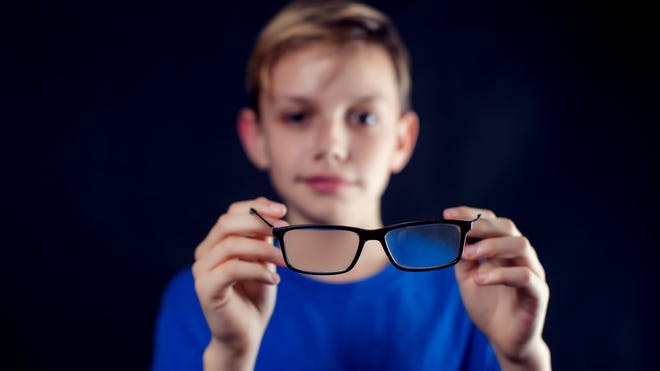What’s myopia? Consultants now calling nearsightedness a illness
Greater than 40% of People are estimated to have myopia, often known as nearsightedness.
Whereas many might contemplate it a minor inconvenience simply remedied with glasses, authors of a report revealed Tuesday are calling on well being companies to categorise it as a illness.
Committee members on the Nationwide Academies of Science, Engineering and Medication say nearsightedness has develop into an “evolving epidemic” that requires extra analysis, standardization of care and early prevention, recommending at the very least one hour of out of doors time each day for youths.
That is the primary time the Nationwide Academies has revealed a report on myopia since 1989. Some analysis suggests myopia might have elevated by 25% from 40 years in the past in elements of the nation, based on the American Optometric Affiliation.
“It was lengthy overdue,” stated Dr. Terri Younger, committee co-chair and professor of ophthalmology and visible sciences on the College of Wisconsin-Madison.
Researchers aren’t precisely certain why myopia is growing a lot, however suppose it might need to do with the period of time kids spend indoors on screens.
“Within the U.S., it is quickly growing and we don’t have a deal with on it,” Younger stated.
What’s myopia? How prevalent is it?
Myopia, or nearsightedness, is a imaginative and prescient situation the place shut objects look clear however far objects look blurry.
This happens when the form of the attention causes gentle rays to bend and focus in entrance of the retina as an alternative of on it. The retina is a nerve in the back of the attention that converts gentle into electrical indicators for the mind to course of into a picture, based on the Mayo Clinic.
The situation usually begins in childhood, stated Dr. Fatema Ghasia, a pediatric ophthalmologist at Cleveland Clinic’s Cole Eye Institute.
Infants are born farsighted, however imaginative and prescient usually corrects with progress. In youngsters with myopia, the attention grows an excessive amount of, passing past the purpose of focusing the picture.

Younger, from the Nationwide Academies report, expects that development to proceed if the U.S. doesn’t implement a concerted, nationwide effort towards stopping and successfully diagnosing nearsightedness in kids.
Myopia hasn’t been thought of an pressing problem up thus far, she stated, however its potential influence on kids ought to make it one. Analysis has proven poor imaginative and prescient decreases tutorial efficiency.
“It simply has a downstream influence on how that little one will operate in society,” she stated.

Tips on how to stop nearsightedness in youngsters
The Nationwide Academies report stated top-of-the-line methods to forestall nearsightedness in youngsters is to spend time outside, at the very least one to 2 hours each day.
“There’s one thing about being exterior, lengthy distances, appreciating horizons (and) completely different wavelengths that someway thwarts myopic growth,” Younger stated.
Throughout days when it is likely to be troublesome to make it exterior, consultants stated being close to home windows and doorways with daylight streaming in can even assist.
It doesn’t need to be sunny exterior, Ghasia stated. What’s necessary is that the kid is uncovered to pure gentle.
Out of doors time is not only the dad and mom’ accountability, consultants say. Colleges and daycares needs to be ensuring college students get sufficient time exterior. A 20-minute recess isn’t sufficient, the Nationwide Academies authors stated.
Whereas the gold customary is at the very least an hour of out of doors time, any time exterior can doubtlessly stop the development of myopia, stated Ghasia.
Diagnosing nearsightedness
Younger stated she’s clocked a “myopic shift” amongst youngsters in her clinic.
This shift is twofold. One is that nearsightedness is being identified at youthful ages. As a substitute of discovering myopia in kids at ages 5 or 6, Younger stated it’s turning into extra widespread to diagnose myopia in kids as younger as 3 or 4.
Docs are additionally seeing a change in what’s thought of regular eyesight. Whereas excellent imaginative and prescient was thought of the baseline, Younger stated this has shifted so that the majority sufferers have at the very least delicate myopia.

Eye docs could possibly sluggish these traits – and possibly even reverse them – if sufferers have been screened, identified and handled early. Nevertheless, the Nationwide Academies report stated the dearth of standardization in care hinders healthcare suppliers from intervening as early as potential.
For instance, sufferers will not be all screened on the identical age. Though Younger recommends kids obtain their first screening at a wellness go to earlier than coming into college, some sufferers aren’t screened till second or third grade. Diagnostic instruments are additionally not standardized; whereas some physician’s places of work use eye drops throughout visible exams, others don’t.
Diagnosing and addressing myopia early is necessary to make sure a toddler’s growth is heading in the right direction, Ghasia stated. Imaginative and prescient isn’t solely tightly linked with lecturers but additionally with sports activities efficiency and social growth. Individuals who have myopia are additionally at elevated threat of different ocular problems like retinal detachment and glaucoma later in life.
“Myopia is not only a nuisance,” she stated. “It has critical long-term ramifications.”
Adrianna Rodriguez will be reached at adrodriguez@usatoday.com.
